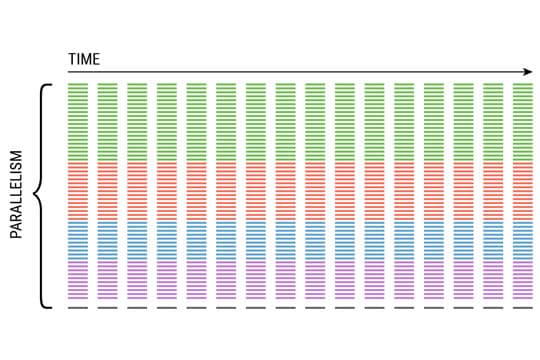
GPU-Accelerated Computing: What are the Perks for GNSS Simulation?
We’re often asked why we promote GPU-accelerated computing as our product differentiator. In short, what benefits does using this software-defined architecture for GNSS simulation offer the user?
Today’s GPUs –readily found as COTS (commercial off-the-shelf) hardware– have been typically associated with computer gaming, and they have been included as standard equipment into the desktop PC since the late 90s for this purpose. Since then, they have continually improved; and now, they can be used for much more than 3D graphics rendering. GPUs have a highly parallel structure that makes them more efficient than general-purpose CPUs for algorithms that process large amounts of data. At their current price range, they offer an unprecedented price-to-calculation-power ratio.
The multi-core structure of the GPU is perfectly suited to parallel processing, such as the generation of multiple GNSS signals
Skydel leverages the computing power of both a PC’s GPU and CPU units. The result is a GNSS simulator that uses affordable COTS hardware instead of proprietary hardware, while achieving top simulation performance.
Demonstration
To illustrate how powerful this GPU-CPU combo is, and how Skydel puts this power to good use, let’s imagine a scenario where we generate the following GNSS signals:
- GPS L1C/A, L2C
- GLONASS G1, G2
- GALILEO E1, E5b
- BEIDOU B1, B2
Let’s assume we have 11 visible satellites per constellation and 2 types of signals per satellite, for a grand total of 88 signals to simulate in real time.
Now, what hardware would be necessary to run an Skydel simulation of all 88 signals? Here’s a quick rundown:
Computer
- CPU: Intel Core i7-6700K Quad-Core 4.0GHz
- GPU: ASUS GeForce GTX 1080
- NIC: Intel X520-DA2 10Gbps SFP+
- OS: Ubuntu 16.04 LTS
Radio (SDR)
- Ettus X300 w/ 2 UBX-160 RF daughterboards and GPSDO
- Accessories (cables, attenuators, etc.)
Bottom line? GPU-accelerated computing provides more than enough computing power for GNSS simulation. Using only COTS hardware, Skydel is able to simulate 88 GNSS signals in real time, including 4 constellations, upper and lower L-bands. All of this, without any compromise to precision or iteration rate.
With this example, the benefits of GPS-accelerated computing become self-evident:
- economies of scale that come with mass-produced hardware
- upgradability to better hardware as they become available
- reusability of generic hardware
Using COTS hardware is a definite advantage for sharing multiple resources among different projects when compared to traditional specialized hardware
Skydel is the only software-defined GNSS simulator that can leverage COTS hardware. Our solutions are not only more affordable, they also allow users to repurpose generic hardware to do more.
That’s just the beginning. There’s more – much more value in the software-defined approach. The scalability and flexibility of Skydel is unrivalled in the GNSS world. Stay tuned for more examples of the benefits of Skydel solutions.


